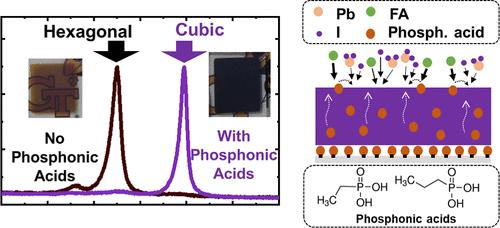当前位置:
X-MOL 学术
›
J. Am. Chem. Soc.
›
论文详情
Our official English website, www.x-mol.net, welcomes your feedback! (Note: you will need to create a separate account there.)
Tailoring Interface Energies via Phosphonic Acids to Grow and Stabilize Cubic FAPbI3 Deposited by Thermal Evaporation
Journal of the American Chemical Society ( IF 14.4 ) Pub Date : 2024-06-27 , DOI: 10.1021/jacs.4c03911 Andrés-Felipe Castro-Méndez 1 , Farzaneh Jahanbakhshi 2 , Diana K LaFollette 1 , Benjamin J Lawrie 3, 4 , Ruipeng Li 5 , Carlo A R Perini 1 , Andrew M Rappe 2 , Juan-Pablo Correa-Baena 1, 6
Journal of the American Chemical Society ( IF 14.4 ) Pub Date : 2024-06-27 , DOI: 10.1021/jacs.4c03911 Andrés-Felipe Castro-Méndez 1 , Farzaneh Jahanbakhshi 2 , Diana K LaFollette 1 , Benjamin J Lawrie 3, 4 , Ruipeng Li 5 , Carlo A R Perini 1 , Andrew M Rappe 2 , Juan-Pablo Correa-Baena 1, 6
Affiliation

|
Coevaporation of formamidinium lead iodide (FAPbI3) is a promising route for the fabrication of highly efficient and scalable optoelectronic devices, such as perovskite solar cells. However, it poses experimental challenges in achieving stoichiometric FAPbI3 films with a cubic structure (α-FAPbI3). In this work, we show that undesired hexagonal phases of both PbI2 and FAPbI3 form during thermal evaporation, including the well-known 2H-FAPbI3, which are detrimental for optoelectronic performance. We demonstrate the growth of α-FAPbI3 at room temperature via thermal evaporation by depositing phosphonic acids (PAc) on substrates and subsequently coevaporating PbI2 and formamidinium iodide. We use density-functional theory to develop a theoretical model to understand the relative growth energetics of the α and 2H phases of FAPbI3 for different molecular interactions. Experiments and theory show that the presence of PAc molecules stabilizes the formation of α-FAPbI3 in thin films when excess molecules are available to migrate during growth. This migration of molecules facilitates the continued presence of adsorbed organic precursors at the free surface throughout the evaporation, which lowers the growth energy of the α-FAPbI3 phase. Our theoretical analyses of PAc molecule–molecule interactions show that ligands can form hydrogen bonding to reduce the migration rate of the molecules through the deposited film, limiting the effects on the crystal structure stabilization. Our results also show that the phase stabilization with molecules that migrate is long-lasting and resistant to moist air. These findings enable reliable formation and processing of α-FAPbI3 films via vapor deposition.
中文翻译:

通过膦酸调整界面能量以生长和稳定热蒸发沉积的立方 FAPbI3
甲脒碘化铅(FAPbI 3 )的共蒸发是制造高效且可扩展的光电器件(例如钙钛矿太阳能电池)的一条有前途的途径。然而,它对实现具有立方结构的化学计量FAPbI 3薄膜(α-FAPbI 3 )提出了实验挑战。在这项工作中,我们证明了 PbI 2和 FAPbI 3在热蒸发过程中形成了不需要的六方相,包括众所周知的 2H-FAPbI 3 ,这对光电性能不利。我们通过在基板上沉积膦酸(PAc)并随后共蒸发 PbI 2和甲脒碘化物,通过热蒸发证明了 α-FAPbI 3在室温下的生长。我们使用密度泛函理论开发了一个理论模型,以了解不同分子相互作用下 FAPbI 3的 α 相和 2H 相的相对生长能量。实验和理论表明,当过量分子在生长过程中可迁移时,PAc 分子的存在可以稳定薄膜中 α-FAPbI 3的形成。这种分子迁移有利于在整个蒸发过程中吸附的有机前体在自由表面上持续存在,从而降低了 α-FAPbI 3相的生长能。我们对 PAc 分子间相互作用的理论分析表明,配体可以形成氢键,以降低分子穿过沉积膜的迁移速率,限制对晶体结构稳定的影响。我们的结果还表明,迁移分子的相稳定是持久的并且耐潮湿空气。 这些发现使得能够通过气相沉积可靠地形成和加工 α-FAPbI 3薄膜。
更新日期:2024-06-27
中文翻译:

通过膦酸调整界面能量以生长和稳定热蒸发沉积的立方 FAPbI3
甲脒碘化铅(FAPbI 3 )的共蒸发是制造高效且可扩展的光电器件(例如钙钛矿太阳能电池)的一条有前途的途径。然而,它对实现具有立方结构的化学计量FAPbI 3薄膜(α-FAPbI 3 )提出了实验挑战。在这项工作中,我们证明了 PbI 2和 FAPbI 3在热蒸发过程中形成了不需要的六方相,包括众所周知的 2H-FAPbI 3 ,这对光电性能不利。我们通过在基板上沉积膦酸(PAc)并随后共蒸发 PbI 2和甲脒碘化物,通过热蒸发证明了 α-FAPbI 3在室温下的生长。我们使用密度泛函理论开发了一个理论模型,以了解不同分子相互作用下 FAPbI 3的 α 相和 2H 相的相对生长能量。实验和理论表明,当过量分子在生长过程中可迁移时,PAc 分子的存在可以稳定薄膜中 α-FAPbI 3的形成。这种分子迁移有利于在整个蒸发过程中吸附的有机前体在自由表面上持续存在,从而降低了 α-FAPbI 3相的生长能。我们对 PAc 分子间相互作用的理论分析表明,配体可以形成氢键,以降低分子穿过沉积膜的迁移速率,限制对晶体结构稳定的影响。我们的结果还表明,迁移分子的相稳定是持久的并且耐潮湿空气。 这些发现使得能够通过气相沉积可靠地形成和加工 α-FAPbI 3薄膜。
















































 京公网安备 11010802027423号
京公网安备 11010802027423号